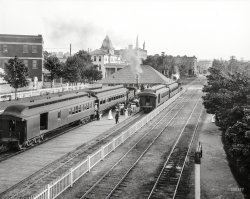
MAY CONTAIN NUTS

Search Shorpy
SHORPY ART

Framed or unframed, desk size to sofa size, printed by us in Arizona and Alabama since 2007. Explore now.
Join and Share
Ad-Free Shorpy
Shorpy is funded by you. Patreon contributors get an ad-free experience.
Learn more.

Recent comments
- Ticket Retention
- Killed by Amtrak
- Back to the Future
- Heckuva remote control!
- Sometimes — Things Go Bump!
- I SEE THE LIGHT
- Union Switch and Signal Company
- Get That Light Out Of My Eyes
- Eggs. Eggs. Eggs. The Egg Man is Here!
- Foreboding caption
- Famous Hollywood faces
- Not just S&P
- re: Those things in the jar
- Up In Smoke
- Medical Smoking
- Quick fix
- A Quink Comment
- If You’re Like Me, Never
- Delivering the News
- U.S.A.
- S&P
- 1940 Zenith radio model 6G601
- Quality goes in before the name goes on!
- Snazzy skirt
- Carbon Arc Lamps
- Illuminate us
- I remember it well
- I can't prove it
- Complicated then, forgotten now
- Bryan-Stevenson
Member Photos
The Shorpy
Print Emporium
Print Emporium
Search Shorpy
Search results -- 30 results per page
- Heavy Lifting: 1908
- Buffalo, New York, circa 1908. "Brown electric hoist unloading ore carrier." ... I kid you not.
(The Gallery, Boats & Bridges, Buffalo NY, DPC, Railroads) ... Posted by Dave - 07/22/2012 - 10:40am -
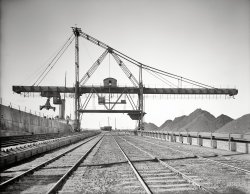
- Ferrous Hauler: 1942
- May 1942. "Kearney, Buffalo County, Nebraska. Farm boy bringing a load of scrap iron to town." ... Posted by Dave - 02/21/2022 - 11:52pm -
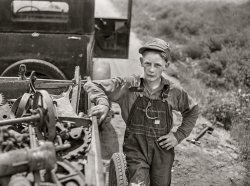
- Hotel Ste. Claire: 1906
- ... and is now (well, as of opening in 2012) the largest Buffalo Wild Wings in the U.S. We lost a lot of downtown Detroit character ... Posted by Dave - 02/27/2016 - 9:30am -
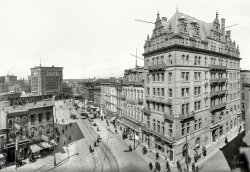
- Bring the Kids: 1917
- ... the Bison enclosure. (We always erroneously called them buffalo.) On the blow up of the photo you can see a bison in the far right ... you want! With Houk "Quik-Change" wire wheels from Buffalo, NY. you can change a flat toot sweet!
Hefty Accessories Those ... Posted by Dave - 10/28/2014 - 7:57am -
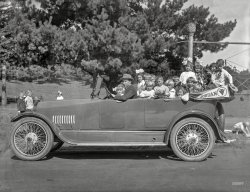
- They Drive by Night: 1949
- ... 1950s Chicago! When our family took the train from Buffalo to St. Paul, we had dinner at some fancy Chicago restaurant. It truly ... Posted by Dave - 06/24/2015 - 10:13pm -
![They Drive by Night: 1949 Chicago, 1949. "Theater traffic on State Street." 35mm negative by Stanley Kubrick, on the outside looking in, for Look magazine. View full size.
John Loves MaryThe same cast of Jack Carson, Marion Hutton and Robert Alda performed in the play John Loves Mary (1947, by Norman Krasna) at the Strand Theatre in New York in February of 1949. Carson was also in the film version (1949) starring Ronald Reagan and Patricia Neal. The Chicago Theatre was built in 1921, is seven stories tall, fills half a city block, and seats 3,600.
That Toddlin' TownWow, this is just how I remember 1950s Chicago! When our family took the train from Buffalo to St. Paul, we had dinner at some fancy Chicago restaurant. It truly was a Toddling Town to this 5-year-old Upstate New York Country Girl!
Shorpy was hereKubrick's photo is from the same vantage as an earlier Shorpy photo from 1907.
Stanley Kubrick?Is this the same "Stanley Kubrick" that directed movies like "2001: a space Odyssey" and "Full Metal Jacket"?
This does show that 35mm film can produce a wonderful nighttime image.
[Yes, that Kubrick. And an early example of the "Kubrick perspective." -tterrace]
State Lake gonebut the Chicago remains.
Cherry Picker Shot?Kubrick's camera appears to be about 25 feet off the ground for this shot. How did he get the camera up that high? Maybe a cherry picker? Or, maybe a sturdy tripod with a vertical extension shaft?
[This way. -tterrace]
Savage! Searing! True!He Walked By Night (1948), B & W film noir, with Richard (Voyage to the Bottom of the Sea) Basehart. Jack Webb was also in this film, and a friendship he formed with a police technical advisor led to the creation of Dragnet.
Greyhound StationGreyhound buses linked up on the right. My Chicago expert (and wife) points out that the Greyhound bus station is to the right around the next corner on Randolph St.
Tech Specs?Anybody care to venture a guess on Stanley's camera/film settings here? There's a blurred car in the center, and blurred people under the theater entrance. What would have been 'typical' pro camera settings then?
State-Lake Theatre still around, sort ofThe building's still there, but unfortunately the interior was gutted in the mid-late 80s and turned into the studio and offices for the local ABC TV station.
(The Gallery, Cars, Trucks, Buses, Chicago, LOOK, Stanley Kubrick)](https://www.shorpy.com/files/images/SHORPY-07255u.thumbnail.jpg)
- F.W. Woolworth: 1940
- ... had become the Kirk Furniture building. Today it houses a Buffalo Wild Wings. The brick building to its right was then called the MNB ... of the building and, when I saw on Street View it is now Buffalo Wild Wings, realized I've been inside it!
(The Gallery, ... Posted by Dave - 02/18/2012 - 3:00pm -
![F.W. Woolworth: 1940 May 1940. "Woolworth Company, Indianapolis, Indiana." 35mm nitrate negative by John Vachon for the Farm Security Administration. View full size.
I grew up on the far I grew up on the far eastside of Indpls and remember the day the Grant building was on fire. I came home from school and it was all over the news, I was young and got the impression the whole downtown was on fire.
CrispThe Woolworth facade is like the crisp dollar bill you find in the middle of the worn and well circulated dollar bills in your wallet.
ConflagrationThe left-most structure was the Thomas Building. It and the Grant building adjacent to it were consumed by a massive fire in November 1973. In all, 15 buildings were either destroyed or damaged.
http://digitallibrary.imcpl.org/ffm/ffmGrant.php
By this time the Woolworth building had become the Kirk Furniture building. Today it houses a Buffalo Wild Wings. The brick building to its right was then called the MNB building and still stands.
This photo shows the backside of the Grant buiding as the fire raged:
Calling Dr. FreudNow there is a building with an inferiority complex!
A Rose Between Two ThornsI don't know what style of architecture that is, but I sure do like it! Those sleek lines and shiny facade just make you want to go in and shop for some moth balls and shaving cream, then wind up at the lunch counter for a burger!
[This is Art Deco style. - tterrace]
Thanks! I thought it was. It looks like what the future should have been!
Still there today!This beautiful Art Deco building is still standing, as is the one to the right of it. I was admiring the Shorpy version of the building and, when I saw on Street View it is now Buffalo Wild Wings, realized I've been inside it!
(The Gallery, Indianapolis, John Vachon, Stores & Markets)](https://www.shorpy.com/files/images/SHORPY_8a06297a.thumbnail.jpg)
- City of Cleveland: 1908
- ... passengers. She did not sail again and was scrapped at Buffalo in 1956.
Pleasure Cruiser This and other lake boats were enjoyed ... Posted by Dave - 07/30/2012 - 4:33pm -
![City of Cleveland: 1908 Circa 1908. "Steamer City of Cleveland, Detroit & Cleveland Navigation Co., Lake Erie Division." 8x10 inch glass negative, Detroit Publishing Co. View full size.
Quite a ContrastThe elegant steamer dressed to the nines contrasted with the spewing soot from her boilers. Breathing on the afterdeck might have been difficult.
Method of PropulsionI assume this steamer is propeller driven? I don't see a paddle wheel.
[Look closely and you'll see that the boat is a sidewheeler. - Dave]
Cleveland SteamerThat is a fabulous picture of the boat, but I always imagined a Cleveland Steamer looking a little different.
A little historyCity of Cleveland III, US.204080, Sidewheel Overnight Passenger Steamer built in 1907 by the Detroit Ship Building Co., Wyandotte, Mich., as Hull #168. Launched January 5, 1907 as City of Cleveland for the Detroit & Cleveland Navigation Co., Detroit, Mich. Length 420 feet by 54 feet wide. Powered by a 6,500 hp three cylinder inclined compound steam engine and eight coal-fired Scotch boilers. Because of a fire in her cabins during fit out at the shipyard, her maiden voyage was delayed a year until May 1908. She was built for the Detroit and Cleveland overnight run. She was renamed City of Cleveland III in 1912. On June 26, 1950 the Norwegian freighter Ravnefjell collided with the City of Cleveland III in early morning fog in Lake Huron off Harbor Beach, Mich. The Norwegian vessel crashed into the D & C liner's cabins but did not penetrate her hull. Four passengers were lost in the collision. The Cleveland III was able to proceed to Detroit where she discharged her remaining passengers. She did not sail again and was scrapped at Buffalo in 1956.
Pleasure CruiserThis and other lake boats were enjoyed by thousands of people in the Great Depression, myself included.
Oars?Just what are those big timbers hanging from the side of the ship?
[Pier bumpers. - Dave]
Side timbersThe timbers on the side of the boats are wood fenders to prevent damage when side docking. When boat is away from the dock the bottom of the fenders are pulled up on deck hanging at about a 45% angle.
(The Gallery, Boats & Bridges, DPC)](https://www.shorpy.com/files/images/4a15980a.thumbnail.jpg)
- Deadeye Dick: 1910
- Student at vocational school in Buffalo, New York. February 1910. View full size. Photograph by Lewis Wickes Hine.
(The Gallery, Buffalo NY, Lewis Hine) ... Posted by Dave - 09/07/2011 - 9:24pm -
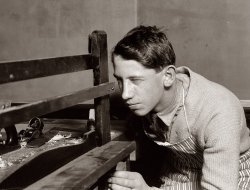
- Detroit Photographic Special
- ... with new management in 1899.
Old 302 began its career as Buffalo Division no. 40 when constructed by Cooke in 1882. She weighed 81200' ... Posted by Dave - 08/13/2012 - 7:26pm -
![Detroit Photographic Special Circa 1890s. "Delaware, Lackawanna and Western Railroad. Detroit Photographic Special." Detroit Photographic Co.'s rolling showroom-darkroom. View full size.
What is thatpointy spiked thing, located on the front of the engine next to the guy closest to the camera?
My Great Uncle's Old JobMy great uncle L.Glover worked for this railroad in the 1950's. His picture can be seen on their website.
Three numbers in three yearsThe Delaware, Lackawanna & Western had the peculiar practice of numbering locomotives for the division they worked; this all changed with new management in 1899.
Old 302 began its career as Buffalo Division no. 40 when constructed by Cooke in 1882. She weighed 81200' on her 57" diameter drivers, and was shop number 1238.
In 1899 the new Truesdale administration renumbered all the company's locomotives into a system-wide series. Hence, Buff.Div. 40 was renumbered 302. With new locomotives coming to the road, many engines were soon renumbered. Number 302 was renumbered DL&W 288 in 1902.
The Lackawanna had a very large number of these 2-6-0 Mogul types; they were used in freight service all over the system for many years. As trains got heavier and speeds increased, these old engines became obsolete all at once, whether they were thirty years or ten years old.Quite a few of these hogs were sold to other railroads or used equipment dealers all over the US and Cuba, but not our former 302; she was scrapped in 1903. [BTW, Dave, great shot. Keep the RR stuff coming...]
Sprayless LocomotiveI can't say I recall seeing fenders/splashguards on locomotive wheels before!
HmmThe sight of that leaky cylinder jacket suggests that we might be looking at some needed-but-deferred maintenance.
Hirsute Grandeur5 out of the 7 gentlemen sport very flamboyant mustaches. I wonder if the two up front on the cow catcher were part of the Detroit crew.
Front end factsThe vertical staffs on both ends of the pilot beam had two traditional uses. First, they acted as a handhold for employees to get from that tiny footboard on the bottom of the flimsy pilot to the pilot deck. Second, there was likely a slot in that staff to accommodate the flags that would be displayed during the daytime to indicate the class of the train.
Note the extended center sill bracketing the coupler. It made contact with the cars it would be shoving as a helper behind a train. These buffers were mostly added to locomotives and coal cars moving the anthracite that was the lifeblood of DL&W's business. These buffers were supposed to prevent jackknifing by the helper shoving too hard.
For you safety buffs, notice the short cut lever to operate the front coupler. Reaching in to "pull the pin" from that tiney footboard during inclement weather more than likely resulted in a report from the railroad that "employee died while irresponsibly moving between train."
The D, L, & WAh, the Delaware, Lackawanna,& Western. My father, who was a New Jersey commuter many years ago, said the letters stood for "delay, linger, and wait."
Cylinder cockThe wisp of steam near the cylinder jacket is coming from a slightly open cylinder cock.
Saturated steamThe 302 ran on saturated steam like the engines from this era. The high-pressure rectangular-shaped cylinders indicate that engine preceded the super-heated steam era.
(The Gallery, DPC, Railroads)](https://www.shorpy.com/files/images/SHORPY_4a20187a.thumbnail.jpg)
- The Library: 1901
- ... the staircase in her home, in a town about 20 minutes from Buffalo, NY. The house is about 100 years old. I've never seen one anyplace ... Posted by Dave - 07/26/2012 - 12:31pm -
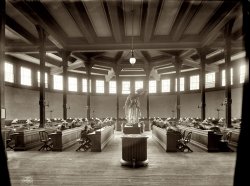
- Howdy Duty: 1953
- ... Princess Summer-Fall-Winter-Spring, Phineas T. Bluster, Buffalo Bob Smith, the Peanut Gallery.
Nice clown Photos of clowns ... say Bob Sandwich Try one today.
Maybe it refers to Buffalo Bob or something on the show?
Inadequate Inflation - Long Bob ... Posted by Dave - 01/27/2019 - 2:33pm -
![Howdy Duty: 1953 June 1953. "Clarabell takes to the hills. Howdy Doody Show character Clarabell the Clown (actor Nick Nicholson) visiting the Dolan family in Boone County, West Virginia." Photo by Phillip Harrington for Look magazine. View full size.
Please help meI think that I'm seeing things. What is that thing out the screen door? It almost looks like a snow blower, but that's a tad unlikely in June (I KNOW it's not western New York, after all).
[It's a thing called an automobile. - Dave]
CreepyI am not anti-Clown, but wow-w
Those were the daysChief Thunder Thud, Princess Summer-Fall-Winter-Spring, Phineas T. Bluster, Buffalo Bob Smith, the Peanut Gallery.
Nice clownPhotos of clowns usually bring out the observations about how scary and creepy they can be, but this particular clown actually has a gentle and sympathetic look on his face. Maybe it’s the furrows in his brow, maybe the sad eyes, but I’m not afraid of him.
Bob Sandwich Bob's Sandwiches would make more sense, but it does indeed say Bob Sandwich Try one today.
Maybe it refers to Buffalo Bob or something on the show?
Inadequate Inflation - Long Bob Sandwich?I am going to guess the balloon refers to the famous Long Bob Sandwich from Bob Phillips Drive-In. The drive-in was just north of Boone County in the Kanawha City part of south Charleston. The drive-in opened in 1952.
Jerry Waters has a site with some photos of this fine establishment: http://www.mywvhome.com/fifties/phillips.htm
BOB SANDWICHDo I see an imprint on one balloon? Can't tell if local delicacy or politician or goodness knows what. I'll take a wild guess that fine print is "Try One Today," but that's wishful thinking. Ideas, anyone?
Mute ClownClarabell never spoke until the last episode of Howdy Doody, when he said with a tear in his eye: "Bye, kids!"
Sung to the tune of "Mademoiselle from Armentières".Who's the funniest clown we know?
Clarabell!
Who's the clown on Howdy's show?
Clarabell!
His feet are big, his tummy's stout,
But we could never do without,
Clara, Clara, Clarabell!
Who has fuzzy-wuzzy hair?
Clarabell!
It's partly red but mostly bare.
Clarabell!
And since the day that he was born,
He's honked and honked and honked his horn.
Clara, Clara, Clarabell!
(Kids, LOOK, TV)](https://www.shorpy.com/files/images/SHORPY-11431u.thumbnail.jpg)
- Corner Pocket: 1918
- ... Were the sons of Nate Salsbury, owner and manager of Buffalo Bill's Wild West Show. In a matter of minutes I found a photo of Nate ... - Milton S Salsbury (Milton Salsbury was the son of Buffalo Bills manager Nathan "Nate" Salsbury.)
Another interesting note ... Posted by Dave - 11/15/2008 - 2:44am -
![Corner Pocket: 1918 June 22, 1918, in or near New York City. "Miss May Schloss at canteen." 5x7 glass negative, George Grantham Bain Collection. View full size.
The Hustleress"I'm really not very good... my brothers tried to teach me... I just knock the balls around most of the time... Oh, a bet? You mean for money? Oh I don't think so... well, I guess we could..."
She's played the game beforeHer left-hand's held in a pretty good bridge, she's down over her cue. I'd say she knows what she's doing. They're obviously not playing eight-ball. Could be some form of rotation since only the high balls are left on the table, or maybe straight pool.
The Original GumpThat would be a rendering of Andy Gump on the blackboard.
http://lambiek.net/artists/s/smith_sidney.htm
Navy has better tailors.Navy was better dressed than Army in 1918, too. Some things are constant through the ages.
Chalk TalkSay, anyone have a clue what's the last word above those cartoon military guys..."Before the Black S...."? Must have something with the 10 days bread and water, but I couldn't figure it out.
["Before the black slave" (there was the infantry). - Dave]
Mrs. SalsburyFrom the New York Times, July 27, 1919:
"Miss May Schloss, daughter of Mr. and Mrs. Henry W. Schloss of 156 West Seventy-fifth Street, who has been prominent in war camp community work in New York, will be married to Nate Salsbury of Chicago on Aug. 2, at the home of her parents, the Rev. Dr. Mussey of the Ethical Culture Society to officiate. Mrs. William H. Schloss, a sister-in-law of the bride-elect, is to be her only attendant. Captain Milton Salsbury is to act as best man for his brother. Mr. Salsbury is connected with Marshall Field in Chicago, where the couple are to reside."
Sharkbite!Is that thumb legal?
Nate Jr. and MiltonWere the sons of Nate Salsbury, owner and manager of Buffalo Bill's Wild West Show. In a matter of minutes I found a photo of Nate Jr and Milton as infants and other photos of their Dad with the stars of the Wild West Show. (Gotta love the Internet!)
New York Times, May 10, 1924, pg 21: "Dissolution Notice": "The co-partnership of Freedman-Salsbury Co., composed of Benjamin H Freedman and Milton S. Salsbury, and also doing business as the Herkules Saw Sales Co. of America with address at 233 Broadway, New York City, has been dissolved." - Milton S Salsbury (Milton Salsbury was the son of Buffalo Bills manager Nathan "Nate" Salsbury.)
Another interesting note -- This Benjamin Freedman tried to blackmail Woodrow Wilson.
Who knew a kooky photo of people playing pool would yield
so much?
(The Gallery, G.G. Bain, WWI)](https://www.shorpy.com/files/images/27137u.thumbnail.jpg)
- American Dream: 1960
- ... frame judging by the rust, is visiting from Detroit or Buffalo
Hey, what's the deal? None of these cars have smashed into ... Posted by Dave - 08/30/2015 - 8:21pm -
![American Dream: 1960 "Two-car families." Columbus, Georgia, circa 1960. Three Fords, an Oldsmobile and a Pontiac. 4x5 acetate negative from the News Archive. View full size.
Day LaborThe two Fords in the foreground don't seem to fit the neighborhood. I suspect they belong to the masons laying the new brick garage behind the two story on the right.
But Ward!My Bridge Club is due to arrive at any moment and Wally parked his Jalopy right in front of the house!
Country SquireThe wagon may be a 1960 Ford Country Squire, need to see a bit more to be certain.
[There's enough showing that we'd be able to see a sliver of the faux-wood side panel if it were, so this is a Ranch Wagon or Country Sedan. -tterrace]
Rust BucketThe 1955 Ford seems to have a lot of rust for living five years in the inland south (no road salt, no ocean air).
In 1965 I bought a 1955 Ford (Florida car, no radio - no heater) off of the Pentagon bulletin board and it had no rust. (purchased for $25.00.. sold 18 months [and one very cold winter] later for $25.00)
Wonder if the '55 could be a transplant from the rust belt??
Chrome memoriesI learned to drive using a 1958 Pontiac Star Chief 4-door (4-speed automatic, 370 cubic inch 4-barrel) that was loads of fun to drive. And the chrome! My, oh my, the chrome!
That '55 FordHas seen some hard times in its five years on the earth--looks more like it should in 1965.
The Ford center framejudging by the rust, is visiting from Detroit or Buffalo
Hey, what's the deal?None of these cars have smashed into each other.
[It's not in Oakland. -tterrace]
Chicago area.This architecture is characteristic of Chicago, where I grew up. The brick and the stone, the awnings, even the garage door design, makes me believe this photograph was taken, perhaps, in the Sauganash neighborhood. I have a hard time believing it is Georgia. Maybe that explains other comments about the rusted cars.
(The Gallery, Cars, Trucks, Buses, Columbus, Ga., News Photo Archive)](https://www.shorpy.com/files/images/SHORPY-615.thumbnail.jpg)
- Franklin Gothic: 1919
- ... the Memories! A friend of my dad's, Mr. Bill Gewand of Buffalo, New York, had a copy of this car back in the late 1950s. As the old ... Posted by Dave - 02/16/2016 - 6:29pm -
![Franklin Gothic: 1919 San Francisco circa 1919. "Franklin Brougham." A car with an air-cooled engine and unusual veed windshield. Latest entry in the Shorpy Catalog of Quirky Conveyances. 5x7 glass negative by Christopher Helin. View full size.
Replica ResidenceThe noble home in the background is at 3800 Washington Street in San Francisco. It was built in 1904 as an homage/knockoff of the Petit Trianon on the grounds of the Palace of Versailles in France.
According to zillow.com, there's currently an offer on it for a cool $18 million (give or take a few sous).
Sugar Daddy's House[An impressive edifice, but it's obviously not Spreckels Mansion. - Dave]
Duh! My bad. I spent 30+ minutes on Street View and Images trying to pin it down w/o success.
Unusual in many waysProbably the most unusual thing about the early Franklins is they used a Wooden frame up to about 1928.
[Many, if not most, autos of the era used wooden frames. - Dave]
Thanks for the Memories!A friend of my dad's, Mr. Bill Gewand of Buffalo, New York, had a copy of this car back in the late 1950s. As the old saw goes, he found it in a barn where the farmer was using it as a chicken coupe, although in this case it was true. It took a lot of TLC, but he got the car looking almost as good as the one in this photo and running like a dream. Your picture brought back happy memories, thank you very much.
["Chicken coupe;" haha, very good. -tterrace]
Thug Mansion3800 Washington was also occupied by a squatter for months recently.
YIPPEE!!!!!!My styling favorite car EVER! Besides a lot of unusual standard features like wooden frame and air-cooled engine, the V or "veed" windshield was a Franklin trait up through the mid-20's; available on their closed cars. It doesn't show well in this photo but if you could see a photo of this dream car from the front, it looks like a spaceship. Too cool; thank you, thank you, thank you!
Design Of The FutureAerodynamic Windpusher.
Wooden It Be NiceThough the Franklin was known for having a wooden chassis, few, if any, major auto manufacturers used them.
[Not so, as owners of brass-era and later cars will attest. Maurice Hendry, in "Cadillac: Standard of the World," recalls an anecdote in which an ash-framed Cadillac chassis proved more resistant to being twisted apart than a steel frame. Below, an excerpt from "Making and Selling Cars: Innovation and Change in the U.S. Automotive Industry." - Dave]
Though I am in no position to argue with a man like Mr. Hendry, he is wrong. Every Model T ford ever built had a steel frame. So did every Dodge, every Durant product, every Maxwell, every Sudebaker (after they went to gasoline powered cars). Pierce, Pope, Stanley, Thomas, Stoddard Dayton, Alco, Locomobile, White, just to name a very few used steel frames. As to Mr. Hendry's assertion that Cadillac used a wooden frame, here is an excerpt from The History of Cadillac.
"The 1903 chassis had angle steel frame with two half-elliptic springs front and rear with straight, tubular front axle. The steering wheel was located on the right-hand side with the controls to the right and using adjustable rack and pinion steering gear. The single tube tires were mounted on 56 cm wood wheels with 12 spokes (14 on the prototype)."
Every Cadillac, ever built, had a steel frame
Wood it, or notCould be that the wood "frame" referred to in some places is the wood that "framed" the body of the cars, and not constituted the chassis' structure. Fisher Body ( read GM) didn't cease wooden framed construction until the mid 1930s. Custom built cars, and low production ones lasted even longer.
Re Wooden It Be NiceIs it possible that the word "frame" is being used in different ways? Certainly the Model T and Model A had a great deal of wood in the "frame" that supported the body panels. This was true of many other cars, and is still true of Morgans (the last time I looked). While I don't know of any that used wood for the "chassis" (another ambiguous word) that supports the axles, driveshaft, etc, I wouldn't be terribly surprised if some early ones did so. Here's a link to diagrams of the "body frame" wood for Ts and As:
http://fordwood.com/
(The Gallery, Cars, Trucks, Buses, Chris Helin, San Francisco)](https://www.shorpy.com/files/images/SHORPY-896.thumbnail.jpg)
- Visitors Welcome: 1906
- ... was apparently on the north side of the 400 block of Buffalo Avenue in Niagara Falls with a nice unobstructed view of the rapids ... structure of The Natural Food Company is located on Buffalo Avenue (occupying ten acres), in the finest residence portion of the ... Posted by Dave - 08/14/2012 - 10:47am -
![Visitors Welcome: 1906 Niagara Falls, New York, circa 1906. "Entrance, Natural Food Conservatory." Breakfast food pioneer Henry Perky's Shredded Wheat factory, a.k.a. "The Palace of Light," was a popular tourist attraction. Bring your appetite, and watch your step. 8x10 inch dry plate glass negative, Detroit Publishing Co. View full size.
They took paradise and put up a parking lot.The "Palace of Light" Shredded Wheat factory was apparently on the north side of the 400 block of Buffalo Avenue in Niagara Falls with a nice unobstructed view of the rapids near the falls.
The site is now a vacant lot with a nice view of the Ramada Inn between it and the rapids.
"The beautiful structure of The Natural Food Company is located on Buffalo Avenue (occupying ten acres), in the finest residence portion of the city, with a frontage of 900 feet on the Niagara Rapids."
Don't look up!I said DON'T look up, there's a guy in the window on the right watching us. Just act cool.
50,000 Vistors Annually!
"V"Why is "Natural" spelled with a "V"? Odd.
[Classicists will recognize that as a Latin (or Roman) U. - Dave]
Creepy, but at least there is a place for your bike...I've noticed people frequently commenting on the lack of bike racks in most of these photos, despite the abundance of bicycles.
Well, this place appears to have two!
Unfortunately, at least in this photo, it also looks like you might not need to secure your bike. After all, you won't be seeing it, or the light of day, again.
The uniforms look likeThey came from West Point, what the cadets wear.
Deveaux studentsMy wife grew up across the street from this building. Her brother attended Deveaux School and according to her the uniforms are identical to what the Deveaux students wore. The brother attend the prep school on a scholarship because their father was serving in WWII. The Deveaux school said the school was preparatory for entry into West Point, but few students actually became West Point Cadets.
(The Gallery, DPC, Factories)](https://www.shorpy.com/files/images/4a11844a.thumbnail.jpg)
- The Flattenator: 1925
- ... Paving Co." Steamroller made by Barber Asphalt Paving of Buffalo, N.Y. National Photo glass negative. View full size.
Their good ... Posted by Dave - 08/05/2012 - 5:39pm -
![The Flattenator: 1925 Washington, D.C., circa 1925. "Crawford Paving Co." Steamroller made by Barber Asphalt Paving of Buffalo, N.Y. National Photo glass negative. View full size.
Their good luck fell out!Didn't Barber know that you're supposed the put the horseshoe with the open end up, to keep the good luck from spilling out?
Also note the terra cotta pipe sections on the left. Standard plumbing fare in the 1920s.
[They look like chimney liners. - Dave]
External DriveInteresting that the drive train, including the cylinders, is external to the body. And with direct gear drive to the wheel! Sorta kinda similar to a Shay locomotive.
Betsy?Looks a bit like Betsy in Disney's "Cars" to me. No power steering in those days, just muscle and then some. There's a thriving steam scene over here in Britain where all sorts of people restore and show these sort of machines. Quite a sight when there are hundreds all together!
http://www.heritagefield.co.uk/gallery/2008/index.html
23-Point TurnsI've used the term "steam roller" my whole life to describe modern road flattening machines, but this is the first time I've actually seen one powered by steam. I love how the crankshaft is right out there in the open, ready to mangle an arm or two. Does that chain connected to the steering wheel provide some sort of power assist? With that screw gear steering system, it was probably quite a job to change direction even while moving.
Alias M.I.L.Also known as "the mother-in-law."
Where in D.C.?Anybody have any ideas where this is? The building in the distance with the semicircular roofline is a real curiosity -- looks a bit like a grain elevator. Also suggestive of an observatory of some type. Very strange to see an arched metal roof in the pre-Quonset hut era. There is also a "jog" in the street in the distance suggesting a public square or bridge.
[There is one last photo on this series that may contain a clue. I'll post it later tonight. - Dave]
Dave, your tease! I'm tingling with excitement in anticipation.
Re: Where in D.C.?From another Crawford Paving photo, here's that siloish building seen above. With ROSSLYN spelled out across the top. Click to enlarge. Maybe near the White Dome shortening plant.
Terra Cotta Pipe SectionsThe ones divided into six sections, known as a "six-way clay conduit," are used for running telephone & telegraph wires underground. I happen to live in the house of a man who made a good living in the manufacture of them. One of his largest customers was Western Electric. These conduits are responsible for helping clean up the tangle of overhead wires - seen in many of Shorpy's early street views - by taking them below ground and out of sight. As a side note, his factory would sell the second quality conduits to many of the farmers and residents around town who would use them to build garages & outbuildings, many of which still stand today.
(The Gallery, Cars, Trucks, Buses, D.C., Natl Photo)](https://www.shorpy.com/files/images/31789u.thumbnail.jpg)
- American Steel: 1910
- ... problems, the first of them being the "Merchant," built in Buffalo in 1862. The "Onoko" merely showed the new possibilities in the size; ... Posted by Dave - 07/28/2012 - 7:20pm -
![American Steel: 1910 Cleveland, Ohio, circa 1910. "American Steel & Wire Co. plant." Your assignment: Create a diorama of this scene using toothpicks, cotton batting, string and cardboard. Panorama made from two 8x10 glass negatives. View full size.
1882-1915The carrier shown above on the Cuyahoga River is the S.S. Onoko, which found fame as both the world's first iron-hull bulk freighter and as the Great Lakes' largest vessel. Launched on February 16, 1882, at the yards of the Globe Iron Works in Cleveland for a group of investors led by Phillip Minch, great-grandfather of the late George Steinbrenner. At over 300 feet in length, the Onoko established a number of cargo-carrying records in the ore, wheat, and corn trades, and became the paradigm upon which virtually all subsequent Great Lakes freighters would be based. Her end came on September 14, 1915, when, just seven miles out of Duluth with a wheat cargo bound for Toledo, the Onoko sprang a leak on Lake Superior, the flood of icy water causing her boiler to explode. The ship's pumps unable to keep pace, she was abandoned by her crew, who were taken aboard the Standard Oil tanker Renown. A view of the Onoko's final minutes:
My ProjectUpon presentation of my assignment, is kerosene an acceptable liquid to represent the Cuyahoga?
[Yes! We will also allow the use of Popsicle sticks or tongue depressors. - Dave]
Stmr. Onoko
Washington Post, Jun 6, 1905.
Great Lake Cargoes.
Immense Growth of Steamers on the Lakes Amounts to a Revolution.
From the Cleveland Leader.
The first cargo of the new steamship E.H. Gary, the record freighter of the Lakes, exceeds the greatest load ever before carried on these inland seas by almost as many tons as any Lake vessel had ever floated twenty-five years ago. It was in 1881 that the Onoko, a steamer built and owned in Cleveland, brought down the first load which reached the 3,000-ton limit. Now the record is placed at over 13,440 tons.
In the twenty-four years the increase in the largest Lake cargo has been nearly 400 per cent. Taking due account of the time required to handle freight at docks and the average speed of heavy vessels between terminals, it is safe to say that one steamer like the E.H. Gary is equal to six such as the Onoko, the latter was a famous and very profitable boat for many years. The rate of progress indicated by such facts is little less than revolution in the business of the Lakes. It is a development rare even in this age and country.
American capacity for handling immense traffic is nowhere more strikingly illustrated than it has been in the traffic which has been built up largely by Cleveland men and Cleveland money, on the most remarkable chain of inland waterways in the world.
Coal Age, 1913.
Coal Shipping on the Great Lakes
by J.W. Chamberlain
The first big revolution of bulk-freight carrying on the lakes came with the steamer "Onoko" in 1882, built of iron. Though not the first metal craft on the lakes, it had such an enormous capacity as compared with most wooden vessels that there was a rush for this new type. Older metal crafts had solved few problems, the first of them being the "Merchant," built in Buffalo in 1862. The "Onoko" merely showed the new possibilities in the size; she had two decks and the old-style stanchions to interfere with bulk-freight handling. ... Steamers of this class were derisively called "tin pans" and it was predicted that they would collapse in stress of weather. They did not, however, and soon a further step was taken, all in the interest of less obstructed holds to facilitate unloading bulk freight.
The ABC of Iron and Steel, 1915.
Transportation of Ore on the Great Lakes
By Ralph D. Williams
In 1882, a departure from the use of wood as ship-building material was made by the construction of the steamer Onoko, at the Globe Iron Works, Cleveland, of iron. The Onoko was 287 feet long and 38 feet beam, and was for the time being the largest deadweight carrier on the lakes. In 1886 the first steel bulk freighter was built on the lakes — the Spokane, for the Wilson Transit Co., at the yard of the Globe Iron Works, Cleveland. Steel speedily became thereafter the only material used in the construction of bulk freighters.
H C Frick Coke Co. BoxcarsThis was the company that belonged to Henry Clay Frick, who as chairman of the Carnegie Steel company was a integral part of the famous 1892 Homestead Steel Strike. As a result of his actions, he was dubbed "The Most Hated Man in America"
(Panoramas, Boats & Bridges, Cleveland, DPC, Railroads)](https://www.shorpy.com/files/images/american_steel_and_wire.thumbnail.jpg)
- Camp Casual: 1863
- ... in the odalisque pose. -Dave]
Lounging in Style Buffalo rug?
Civil War chapeaux What an incredible assortment of hats! ... Posted by Dave - 04/30/2013 - 10:59am -
![Camp Casual: 1863 June 1863. "Fairfax Courthouse, Virginia. Capt. J.B. Howard, Office of Assistant Quartermaster, Army of the Potomac." A colorful crew, even in monochrome. Wet plate glass negative by Timothy O'Sullivan. View full size.
Early OnIt looks like the issuing of uniforms hasn't taken place quite yet. A tad informal.
Dress, undress and an educated guessAmong the duties of Union Quartermaster's Department was the transportation of material and food stuffs for the army. Like many armies of the 19th century, they employed civilian teamsters to handle the wagons.
Of the twelve men in the image, only four are clearly military and of those, only one is clearly an officer. The man standing to the left of the tent pole is a 2nd lieutenant judging by the absence of other insignia on his shoulder straps. The fellow in the "french girl" pose is a bit more problematic. He wears a shell jacket which was seen in the field on both officers and enlisted men. The gentleman doesnt look quite as field worn as the others. We can't see what's on his shoulder straps but based on his natty appearance (bowtie and pleated shirt), I'd hazard a guess that he's the Capt. Howard in the caption.
[The top dog in these camp scenes was almost always the one in the odalisque pose. -Dave]
Lounging in StyleBuffalo rug?
Civil War chapeauxWhat an incredible assortment of hats! Practically no two alike. Top prize to the man in the middle leaning on the signpost.
"Say Cheese!"Apparently this photo pre-dates that attention grabbing phrase.
Thought balloonGuy, second left: "Draw me like one of your French girls."
Impromptu styleI am guessing no one posed these handsome fellas and yet each of them has both a very individual stance and a different spot they're gazing at which makes for quite a unique picture (and if they were "posed", kudos to their photographer for such an interesting shot!)
(The Gallery, Civil War, Timothy O'Sullivan)](https://www.shorpy.com/files/images/SHORPY_04040a.thumbnail.jpg)
- GLEW: 1906
- ... View full size.
Freighter Hill Sold Again Buffalo Morning Express
FREIGHTER HILL SOLD AGAIN
Detroit, Sept. ... Ecorse yard for use in the package freight trade between Buffalo and Lake Superior. The new owners already operate several boats in ... Posted by Dave - 08/14/2012 - 2:11pm -
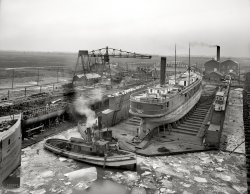
- Camp Flying Eagles: 1908
- ... The Chief is probably thinking I could have been riding in Buffalo Bill's Wild West Show and my parents sent me here!!!
O Connecticut ... Posted by Dave - 10/27/2019 - 3:24pm -
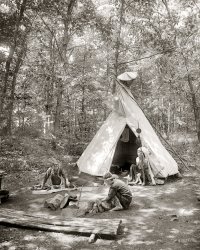
- The Motor Fire Engine: 1913
- ... pics at the SPAAMFAA site .
Fire Engine Engine Buffalo Marine (Buffalo Gasoline Engine Co.) 6 1/4" x 6 3/4" bore and stroke six cylinder ... Posted by Dave - 09/08/2011 - 11:57am -
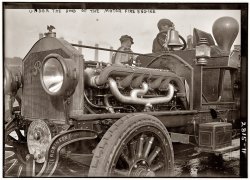
- Glen Echo: 1925
- ... cars, where I waited for several hours around 1955 to meet Buffalo Bob from Howdy Doody.
After the long wait we were rewarded with Buffalo Joe or some such name as Bob had a more pressing commitment.
Amen ... Posted by Dave - 08/24/2013 - 6:49pm -
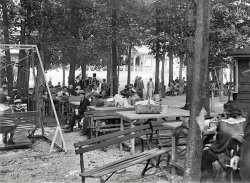
- Parcel Post: 1914
- ... Ga., 2 Whites; Baltimore, 3 Whites; Brooklyn, 3 Whites, Buffalo, 2 Whites; Columbia, S. C, 1 Wagenhals; Columbus, O., 2 Wagenhals; ... Posted by Dave - 08/09/2012 - 6:47pm -
![Parcel Post: 1914 Washington, D.C., 1914. "Post Office Department -- parcel post." A scene outside the post office on Pennsylvania Avenue in its final year of operations before it moved and the building became known as the Old Post Office. View full size.
U-shaped bracketsNice truck! I'd love to have it in that condition right now. My question is, what are those big u-shaped brackets in front of the radiator? Maybe for headlights? If so, what are the smaller lights mounted on either side of the dashboard? Oh, and of course, what make and year is the truck?
[The small lamps are running or parking lights. - Dave]
In the DarkWhere are the headlights?
Parcel Post serviceThis was the year after the Post Office Department began domestic Parcel Post service. Originally, a series of special stamps was issued.
"Neither rain, nor sleet, nor snow"Only darkness will stop them from their appointed rounds. Notice the headlights seem to be missing from the bracket holders.
Dark of Night"Neither snow nor rain nor heat nor gloom of night stays these couriers from the swift completion of their appointed rounds". I think the "gloom of night" might stay this one.
Righty?Right hand drive? Was that common in those days?
[Still the case for mail delivery vehicles. -tterrace]
KisselKar truckThis is a 1913 KisselKar truck, made by the Kissel Motor Car Company of Hartford, Wisconsin.
In July 1913, to prepare for the domestic Parcel Post delivery service that tterrace mentioned, the United States Post Office Department's Committee of Award accepted a bid by the White Company for 20 vehicles rated at 3/4 ton capacity. They cost $2,060 each and had to be equipped with either pneumatic or cushion tires, depending on what the Post Office decided. The Post Office also ordered 21 Wagenhals Motor Car Company three-wheeled vehicles that had 800 pounds capacity. Powered by a 20 hp water-cooled four-cylinder engine, they cost $625 each (visually similar to the less expensive electric version below). Located in Detroit, the Wagenhals Motor Car Company would reorganize just a month later as simply the Wagenhals Motor Company. Both the Whites and the Wagenhals had to be delivered to Cleveland, Ohio within sixty days.
A year later the Post Office was advertising for bids for spare parts for these vehicles, which included: "Transmission and cup grease, horn bulbs, cylinder and heavy oil, blow out and tube patches, pressure gauges, cushion and pneumatic tires, inner tubes, tire tape, valve parts and tools, vulcanizing rubber, etc."
The winner of the bid had to supply each individual post office named in the contract, and the parts just couldn't be dumped in front—the bid proposal stipulated that "All the supplies must be delivered at and within the doors of the post offices."
The bid proposal noted that the Whites and Wagenhals had been dispersed as follows:
Atlanta, Ga., 2 Whites; Baltimore, 3 Whites; Brooklyn, 3 Whites, Buffalo, 2 Whites; Columbia, S. C, 1 Wagenhals; Columbus, O., 2 Wagenhals; Detroit, 2 Wagenhals; Louisville, 2 Whites; Memphis, 3 Wagenhals; Minneapolis, 4 Whites; Nashville, 3 Wagenhals; Norfolk, Va., 2 Wagenhals; Philadelphia, 6 Whites, Richmond, Va., 2 Wagenhals.
Two possibilitiesThe headlamps are, being actual brass lanterns, probably on a bench getting cleaned and filled (or re-carboned). No reason to rattle around with them on the truck all day long. Or maybe they just don't drive this truck at night.
[Many if most trucks of the era didn't have headlights. The brass fixture illustrated below is an acetylene gas lamp. - Dave]
Believe it or notIn the early years of the auto business the lights were optional. I suppose driving after dark was pretty dicey even with the improved illumination provided by acetylene. For a business that normally operated during daylight hours I imagine that the expense and hassle of the lights was not worthwhile.
Speedy Delivery
Washington Post, March 2, 1913.
Five Kissel cars, bought by the government for parcel post in the city of Washington, D.C., have been placed in service after a thorough inspection by Postmaster General Hitchcock and Postmaster Merritt, of Washington. They are 30-horsepower wagons of 1,500 pounds carrying capacity, and are painted a brilliant red. On its initial run one of the cars made 152 stops between 8:30 a.m. and 12 noon.
Brilliant red was not what I was picturing for this vehicle when first looking at the photo. I had thought a more institutional green or dark blue, but with enough squinting I can begin to imagine red, perhaps a color chosen to express speed and priority.
(The Gallery, Cars, Trucks, Buses, D.C., Harris + Ewing)](https://www.shorpy.com/files/images/SHORPY_03914a_2.thumbnail.jpg)
- Lil Farmers: 1959
- ... set?
Oh, and the metal airplane looks like a "Brewster Buffalo" to me. The Buffalo was a short lived fighter at the outbreak of WW2.
I'd take any of ... Posted by Dave - 12/25/2012 - 5:53pm -
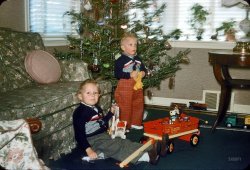
- This Old New House: 1900
- ... in Lake View, New York (about twenty-thirty miles south of Buffalo, NY) cited in the advertisement is still standing and happily occupied ... Posted by Dave - 03/03/2016 - 4:33pm -
![This Old New House: 1900 From around 1900 we bring you someone's new house in the vicinity of Stafford, Connecticut. Fancy millwork abounds! 5x8 glass negative. View full size.
That is a beautiful home... but it looks to me like the owner should invest in a lawn mower.
[He's on his way to pick up a scythe at Home Depot. - Dave]
Beautiful house, butMy first reaction was, "Wow, would I hate to have to paint that baby!"
Gingerbread Kit? Looks like the sort of house you could order from the Sears catalog:
Lawn CareOr they could be out getting a couple of goats.
It Never Rains in Connecticut!So no need for gutters or downspouts.
First, Second, and Third Reaction, and CountingIn my last neighborhood of some 25 years, I had a neighbor who had one of those 3-story Victorian things all covered in gingerbread. When I first moved there, the house was merely 2-color. About ten years later, the neighborhood was zoned "historic" and the local "hysterical commission" ruled that all renovations should be rigidly return to originality. Painting thereafter included a process of paintchip lab analysis to determine original colors. So I watched my neighbor tediously paint that gingerbread behemoth in seven colors, much of it on countless lathe-turned bits. Sure, it was pretty when it was all done, but....It made me absolutely love my slightly moldy brick.
My first thought (and my mother's as well) on the current acreage with grass like that was "goats", but I've learned to simply appreciate the sight of grass just like that in the home shown here--it's positively lovely to watch ripple like waves on a pond on a breezy day, while providing a habitat for countless butterflies by day and fireflies in the millions by night. One of my neighbors does goats, while another does llamas.
Re: Gingerbread kitThe kit home in Lake View, New York (about twenty-thirty miles south of Buffalo, NY) cited in the advertisement is still standing and happily occupied to this day. Those homes, while being kit homes, were built to last!
IlluminatingI'm intrigued by the lamppost, which looks very modern!
The Handsome Gas LampNote that the lamppost has two crossbars near the bottom and one just below the lamp. This is almost certainly a gas lamp. The crossbars at the bottom are steps for the lamplighter, and the one at the top is a hand-hold or ladder rest.
Also note the lack of any signs of electrical service to the house.
[Also note the lamppost stops before it gets to the lamp. This is a kerosene fixture with a burner on top. - Dave]
(The Gallery, Small Towns)](https://www.shorpy.com/files/images/SHORPY-912A.thumbnail.jpg)
- Stop Bryan-Kern: 1908
- ... East on Niagara Street, away from the Falls, towards Buffalo.
I too looked at the Google streetview. Very sad. There are ... Posted by Dave - 08/21/2012 - 1:22pm -
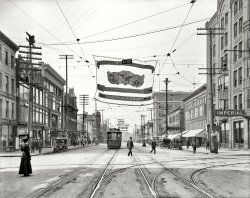
- Spud Noel: 1925
- ... today by Maj. F.C. Fegley, who arrived here yesterday from Buffalo, N.Y., for that purpose. A large building was leased at 22 R street ... Mrs. Fegley have been in charge of the Volunteer work in Buffalo, N.Y., for the last two years. The Salvation Army and the American ... Posted by Dave - 08/13/2012 - 6:09pm -
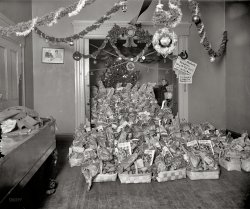
- Dog Cakes: 1910
- ... in his "cakes" and early ads in England intimated it was buffalo.
(The Gallery, Dogs, DPC, Stores & Markets, Utica) ... Posted by Dave - 08/15/2012 - 3:06pm -
![Dog Cakes: 1910 Utica, New York, circa 1910. "United Commercial Travelers of America building." On a block offering a cornucopia of goods and services: Dog Cakes (not to be confused with Twentieth Century Lunch three doors down), dog collars, bananas, cigars, an amusement arcade (the Shooting Gallery), coal, shoes, trunks and, finally, crockery and glassware. 8x10 inch glass negative View full size.
Close to homeThis building is now an apartment complex, but most of the buildings to the right are gone, lost in a massive fire in 1948. Among them was my father-in-law's store, just out of the picture. If you could pan to the right, I'd appreciate it!
[Done. - Dave]
OK I'll BiteWhat's a dog cake?
What better to eat with Dog Cakes butDog Milk!
I took this photo of a can of Dog Milk that I saw in a Restaurant where I was dining in Japan a few years ago.
I asked the waitress how many dogs had to be milked to get a whole can of Dog Milk, but she didn't seem to understand.
70 Genesee StreetIn 1905, the company needed more office space and moved to this building, at 70 Genesee Street in downtown Utica, within sight of the Erie Canal.
In 1937, the building was tripled in size to accommodate the needs of more than 200,000 policyholders.
View Larger Map
The lunch is up to dateI'm reassured. If they advertised a 19th Century lunch, it would be ten years past its expiration date. Which is only four years past the Pure Food and Drug Act.
Kid-Free Eatery"20th Century Lunch -- For Ladies and Gentlemen"
Penny ArcadeThat's a great view of an old penny arcade, taken at a time when many of the attractions actually did cost only one cent. At the doorway is what appears to be a 44-note piano. These were usually set up to play a tune for a nickel, although the operator could have set it to play continuously as a means to entice passersby to enter. Along the right wall can be seen a row of Mutoscopes similar to the ones in the photo below. These played a moving picture supplied by individual frames printed on cards and formed into a reel. Each real contained one short movie, and since each Mutoscope held only one reel, the arcade would have many Mutoscopes in order to offer a variety of movies.
"Dog Cakes" - No dogs addedSpratts "Dog Cakes" was the first mass-produced dog food. James Spratt came up with "Patented Meat Fibrine Dog Cakes" after seeing dogs eating hardtack biscuits. The biscuits were initially marketed to country gentlemen in England for their hunting dogs.
Production was relatively limited until after James Spratt's death. However, in the 1880s, the company went public and became one of North America's marketed company in the 20th Century. They were eventually bought out by Purina.
Charles Crufts, who founded the Cruft's Dog Show began as a clerk for Spratt's.
Spratt was secretive about the actual meaty ingredient in his "cakes" and early ads in England intimated it was buffalo.
(The Gallery, Dogs, DPC, Stores & Markets, Utica)](https://www.shorpy.com/files/images/4a19575a.thumbnail.jpg)
- Double Truck: 1941
- ... hood ornament is visible.
Eastern Auto Forwarding of Buffalo, New York had orange trucks with green lettering. Their motto was ... to transport new vehicles. The firm was bought out by Buffalo based M&G Convoy in 1964.
Markel Spotting There's at least ... Posted by Dave - 11/12/2017 - 2:07pm -
![Double Truck: 1941 October 1941. "Car transport filling up with gas at Little Falls, New York." Medium format negative by John Collier. View full size.
What make ?Is this a GMC cab over?
[Dodge. -tterrace]
There's one hidingI've never seen one like this either but I found a pic of a similar setup with open sides.
Chevy hidden insideToo much Dodge on the outside for it to handle.
The Sticker on the TruckI remember seeing trucks with that sticker having an "M" inside the shape of the US. Does anyone know what that signifies?
"M" Is For MarkelThe sticker on the truck that "Vonderbees" asked about is from Markel Service, Inc. Markel insured buses and trucks starting in 1930, and it was also involved in promoting safety and standards for drivers. The firm also helped to pass the National Motor Carrier Act of 1935. The firm exists today as Markel Corporation, and it is a Fortune 500 company.
As a part of their program to promote safety, drivers were given safety awards for each year that they did not have an accident. A variety of these awards and award certificates is shown below. The pin with number "1" in the red diamond is believed to be an early award as few of these are known to exist. Awards in the style of the 4-year pin shown seems to have followed, but these were likely awarded for only a short period of time as these are also very hard to find. Pins in the style of the 15-year award shown were issued into the 1950s, and the 20-year award was the last style issued.
The other side of the Dodge truck is seen in the photo below. The truck is from 1940, and this was the first year that the Dodge cab-over truck body was entirely designed, engineered, and built in-house. The previous three years the body was manufactured by Montpelier Company of Montpelier, Ohio. The 1940 models are easily identified by the lack of cowl lights which were on the 1941 and 1942 models. In this initial year of production 1 1/2 ton and 2 ton models were available. The cab could seat three, and it was up high enough that the floor of the cab was flat. The directional (turn) signal lights are mounted on the fender tops, and a Dodge ram hood ornament is visible.
Eastern Auto Forwarding of Buffalo, New York had orange trucks with green lettering. Their motto was "Dependable As The Rising Sun." They once had a fleet of 385 rigs, but by 1964 this was reduced to 50 as the railroads became a more efficient means to transport new vehicles. The firm was bought out by Buffalo based M&G Convoy in 1964.
Markel SpottingThere's at least one more truck with the Markel symbol on Shorpy. See it here.
(The Gallery, Cars, Trucks, Buses, Gas Stations, John Collier)](https://www.shorpy.com/files/images/SHORPY-8c33337a1.thumbnail.jpg)
- Day Trippers: 1906
- ... My maternal grandfather born 1900, 13-miles south of Buffalo NY. Papa often spoke of his boyhood, how he and friends would meander ... Posted by Dave - 04/20/2016 - 12:16pm -
